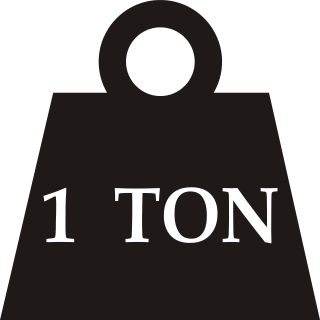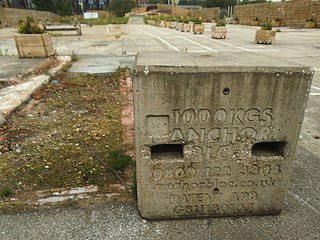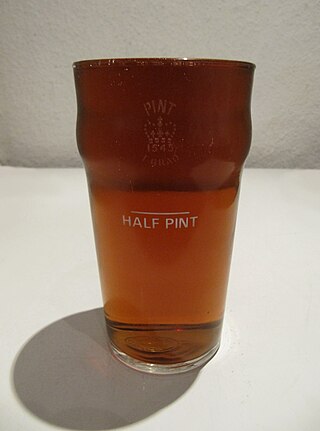Related Research Articles

The gallon is a unit of volume in British imperial units and United States customary units. Three different versions are in current use:

The kilogram is the base unit of mass in the International System of Units (SI), having the unit symbol kg. It is a widely used measure in science, engineering and commerce worldwide, and is often simply called a kilo colloquially. It means 'one thousand grams'.

The litre or liter is a metric unit of volume. It is equal to 1 cubic decimetre (dm3), 1000 cubic centimetres (cm3) or 0.001 cubic metre (m3). A cubic decimetre occupies a volume of 10 cm × 10 cm × 10 cm and is thus equal to one-thousandth of a cubic metre.

The pound or pound-mass is a unit of mass used in both the British imperial and United States customary systems of measurement. Various definitions have been used; the most common today is the international avoirdupois pound, which is legally defined as exactly 0.45359237 kilograms, and which is divided into 16 avoirdupois ounces. The international standard symbol for the avoirdupois pound is lb; an alternative symbol is lbm, #, and ℔ or ″̶.

Ton is any of several units of measure of mass, volume or force. It has a long history and has acquired several meanings and uses.

The tonne is a unit of mass equal to 1000 kilograms. It is a non-SI unit accepted for use with SI. It is also referred to as a metric ton to distinguish it from the non-metric units of the short ton and the long ton. It is equivalent to approximately 2204.6 pounds, 1.102 short tons, and 0.984 long tons. The official SI unit is the megagram, a less common way to express the same amount.

The kilogram per cubic metre is the unit of density in the International System of Units (SI). It is defined by dividing the SI unit of mass, the kilogram, by the SI unit of volume, the cubic metre.
The ounce is any of several different units of mass, weight, or volume and is derived almost unchanged from the uncia, an Ancient Roman unit of measurement.

The pint is a unit of volume or capacity in both the imperial and United States customary measurement systems. In both of those systems it is traditionally one eighth of a gallon. The British imperial pint is about 20% larger than the American pint because the two systems are defined differently. Almost all other countries have standardized on the metric system, so although some of them still also have traditional units called pints, the volume varies by regional custom.
The quintal or centner is a historical unit of mass in many countries which is usually defined as 100 base units, such as pounds or kilograms. It is a traditional unit of weight in France, Portugal, and Spain and their former colonies. It is commonly used for grain prices in wholesale markets in Ethiopia and India, where 1 quintal = 100 kg (220 lb).
The long ton, also known as the imperial ton or displacement ton, is a measurement unit equal to 2,240 pounds (1,016.047 kg). It is the name for the unit called the "ton" in the avoirdupois system of weights or Imperial system of measurements. It was standardised in the 13th century. It is used in the United Kingdom and several other Commonwealth of Nations countries alongside the mass-based tonne defined in 1799, as well as in the United States for bulk commodities.

A bushel is an imperial and US customary unit of volume based upon an earlier measure of dry capacity. The old bushel is equal to 2 kennings (obsolete), 4 pecks, or 8 dry gallons, and was used mostly for agricultural products, such as wheat. In modern usage, the volume is nominal, with bushels denoting a mass defined differently for each commodity.

A barrel is one of several units of volume applied in various contexts; there are dry barrels, fluid barrels, oil barrels, and so forth. For historical reasons the volumes of some barrel units are roughly double the volumes of others; volumes in common use range approximately from 100 to 200 litres. In many connections the term drum is used almost interchangeably with barrel.
The at sign, @, is an accounting and invoice abbreviation meaning "at a rate of", now seen more widely in email addresses and social media platform handles. It is normally read aloud as "at" and is also commonly called the at symbol, commercial at, or address sign.
A system of units of measurement, also known as a system of units or system of measurement, is a collection of units of measurement and rules relating them to each other. Systems of measurement have historically been important, regulated and defined for the purposes of science and commerce. Instances in use include the International System of Units or SI, the British imperial system, and the United States customary system.
The tun is an English unit of liquid volume, used for measuring wine, oil or honey. Typically a large vat or vessel, most often holding 252 wine gallons, but occasionally other sizes were also used. The modern tun is about 954 litres.

The gram per cubic centimetre is a unit of density in the CGS system, and is commonly used in chemistry. It is defined by dividing the CGS unit of mass, the gram, by the CGS unit of volume, the cubic centimetre. The official SI symbols are g/cm3, g·cm−3, or g cm−3. It is equivalent to the units gram per millilitre (g/mL) and kilogram per litre (kg/L). The density of water is about 1 g/cm3, since the gram was originally defined as the mass of one cubic centimetre of water at its maximum density at 4 °C.
A number of units of measurement were used in South Africa to measure quantities like length, mass, capacity, etc. The Imperial system of measurements was made standard in 1922 and the metric system was adopted in 1970.
Villarriba and Villabajo are two fictional Spanish villages that serve as the setting for a series of advertising campaigns for Procter & Gamble's Fairy brand. Originally created in Spain in 1991 for Fairy dishwashing liquid, the campaign has been renewed over the years, expanded to other products of the brand and used in several international markets.
References
- ↑ "arroba". Diccionario de la lengua española. Real Academia Española. Retrieved 2020-02-14.
- ↑ La República, En Feria de la Mujer Emprendedora presentan antibióticos naturales saludables (in Spanish)
- ↑ Arroba in Bolivia Archived February 6, 2010, at the Wayback Machine